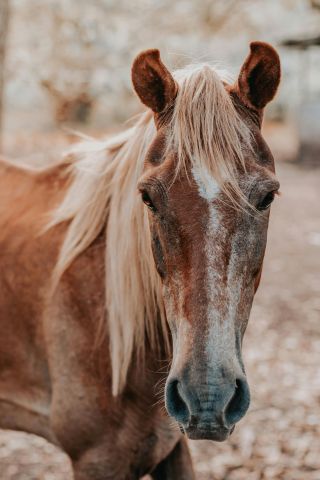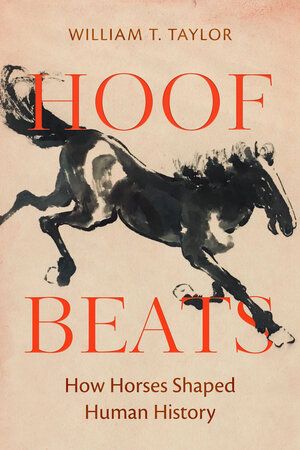Relationships
'Hoof Beats': How Horses Altered the Course of Human History
William Taylor's new book explores how horses helped shape our past and present.
Posted August 3, 2024 Reviewed by Margaret Foley
Key points
- Many people know about horses only through racing and sport headlines that don't show who horses truly are.
- Taylor's book places horses at the origins of globalization, trade, biological exchange, and social change.
- Readers will get a sense of the depth, antiquity, and importance of the human connection with horses.

Horses are majestic, sentient, intelligent, and highly sensitive animals who are used in a wide variety of situations involving humans. The bond between horses and humans has spanned time and many different civilizations. I don't know much about the history of human-horse relationships but when I've been in the presence of these amazing beings I can feel that embedded in their genes there are remnants of a long association with Homo sapiens. Of course, for ancient and wild horses there is a fascinating story underlying the development of horse-human relationships. I was thrilled to learn of a new book, Hoof Beats: How Horses Shaped Human History by Dr. William Taylor, an archaeozoologist at the University of Colorado, that answered most of the questions I had about how horses have shaped human cultures globally in many different contexts. To learn more about the central role that horses played in altering the course of human history, Taylor uses discoveries that have placed the horse at the origins of globalization, trade, biological exchange, and important social changes.

I found Taylor's book to be a wonderful companion to Chad Hanson's In a Land of Awe: Finding Reverence in the Search for Wild Horses, in which he offers valuable insights about what it is like to be a wild horse, where and how they would choose to live in the best of all possible worlds, what they need to express their unique personalities and wildness, and the importance of wildness for human well-being.
Here's what Taylor had to say about his recently released and highly acclaimed book.
Marc Bekoff: Why did you write Hoof Beats?
William Taylor: I’ve been working for the last decade trying to understand horse domestication through archaeological research in different corners of the world, from the Mongolian steppes, the mountains of Central Asia, the Great Plains, and the Pampas of the Americas. Over that time, I’ve seen so many enormous changes in our discipline that have rewritten our understanding of human-horse relationships in the ancient world, but there was no book out there that drew all of these new discoveries and perspectives together, really relying on the science and looking through a global lens.
MB: How does your book relate to your background and general areas of interest?
WT: Growing up in Montana, I was always part of a horse culture. My grandpa was a classic Montana cowboy, but I was the first generation that grew up without horses. So, I’ve always been curious about the ways that horse domestication made us who we are, and how that has changed over the centuries. Once I became a scientist, I specialized in understanding horses, specifically in a discipline known as archaeozoology: using horse bones and other archaeological clues to shed light on ancient domestication and human-animal relationships.
Hoof Beats is really drawn from my fieldwork in different horse cultures around the world. The book builds outwards from that personal experience and draws in all the important discoveries over the last few decades to tell a new story of how horses gave us the world we live in today.
MB: Who do you hope to reach in your interesting and important book?
WT: This book is really written for anyone who is curious about horses and people, from members of the public who love animals or archaeology all the way to students or scholars. Although Hoof Beats pulls together top-level science, it’s written in plain language and it’s exciting and beautifully illustrated. My hope was to write a book of the sort that I’d actually want to read myself.
MB: What are some of the major topics you consider?
WT: The book starts off with a bold revision of our understanding of the timing and nature of the first domestication of horses, drawing upon some really striking discoveries from the last few years that have upturned some of our most basic assumptions about when and where horses first came into the fold of human societies. It then explores some of the most important inflection points in the human-horse story, from the beginnings of horse transport through the rise of steppe empires and the spread of horses to cultures in every corner of the world.
MB: How does your book differ from others that are concerned with some of the same general topics?
WT: Unlike some other books that have looked at horse domestication, this one is built squarely on the science, coming firsthand from my experience as an archaeological scientist. One of the important things that readers of Hoof Beats will find that you won’t see in any other book is original research that comes out of places like Mongolia, Central Asia, Argentina, Africa, and the Great Plains. These are areas that are home to the world’s greatest horse cultures but have often been left out of written records, and we haven’t appreciated their role in shaping the global human story.
Just last year, for example, we found that domestic horses spread across western North America much earlier than once believed on the basis of historic records, and that the world’s oldest wooden saddle and stirrups might have come from the Mongolian steppes—readers will get these dynamic details here, directly “from the horse’s mouth,” so to speak.
MB: Are you hopeful that as people learn more about horse-human relationships they will come to understand who these amazing animals are treat them with more respect and dignity, and work harder to coexist with them when conflicts arise?
WT: In many cases around the world, from the wild horses of the American West to the conservation of Przewalski’s horse in Asia, debates (or even heated arguments) over what to do about horses in the present are directly connected to our understanding of the past. Especially here in the western United States, the changing social role of horses has left us with some particularly challenging and tense questions around horses, both domestic and wild, including where do they belong and what is their role in an industrialized world?
I hope that in the pages of Hoof Beats, readers will get a sense of the depth, antiquity, and importance of the human connection with horses. I think that when you consider the extraordinary history and prehistory of that connection, it’s impossible not to value it.
One takeaway I think readers will walk away with is the sense that from the Plains to the steppes and everywhere in between, human-horse relationships are not just a thing of the past but also an active part of the future, from our cultural resilience to better scientific understanding of this rapidly changing world. Our world as we know it would not exist if not for horses, and we can learn a lot about ourselves and our place in that world through studying our relationship with them.
References
In conversation with Dr. William T. Taylor, Assistant Professor of Anthropology and Curator of Archaeology at the University of Colorado, Boulder. His research focuses on the relationship between humans and animals, centering on the story of horse domestication, with a technical emphasis on using archaeozoology, archaeological science, and emerging technologies. He has ongoing research around the world, from the Plains and Pampas of the Americas to the steppes of Mongolia.




